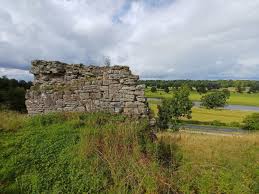Your basket is currently empty!
Introduction
In the heart of the Scottish Borders once stood a mighty medieval fortress—Roxburgh Castle. Today, little more than grassy mounds remain, but this site was once one of the most important castles in medieval Scotland. Contested by kings, captured in wars, and ultimately erased by time, Roxburgh Castle is a lost jewel of Scotland’s turbulent past.
The Rise of Roxburgh Castle
Built in the early 12th century by King David I of Scotland, Roxburgh Castle stood near the confluence of the Rivers Tweed and Teviot. It quickly became one of the four great royal castles of the Scottish Borders—alongside Edinburgh, Stirling, and Berwick.
Its location made it a key administrative center, with a thriving burgh (town) developing around it. Roxburgh was even considered a contender for Scotland’s capital during the medieval period.
A Strategic Stronghold on the Borders
Roxburgh Castle’s position was no accident. Placed between Scotland and England, it was a military and political hotspot. For centuries, the castle was at the center of the Anglo-Scottish Wars, changing hands dozens of times.
Its elevated position offered a commanding view of the valley, making it an ideal stronghold for controlling the Scottish Borders. Whoever held Roxburgh controlled the gateway between two kingdoms.
Wars, Sieges, and Destruction
The Wars of Scottish Independence in the late 13th and early 14th centuries saw Roxburgh constantly contested. English forces under Edward I seized it in 1296, and it remained under English control for much of the next 150 years.
One of the most famous events occurred in 1460, when King James II of Scotland attempted to retake Roxburgh. During the siege, a cannon exploded, tragically killing the king. However, Scottish forces succeeded in capturing and destroying the castle shortly afterward to prevent its reuse by the English.
Why Was Roxburgh Castle Abandoned?
After its destruction in 1460, Roxburgh Castle was never rebuilt. By the time of the Treaty of Perpetual Peace in 1502 between England and Scotland, the strategic value of the site had diminished. The nearby town of Roxburgh also disappeared, likely due to war and shifting trade routes.
Centuries of erosion, plundering for stone, and neglect left the once-great castle reduced to ruins. Today, few people realize just how important Roxburgh once was.
What Remains Today?

All that remains of Roxburgh Castle are grassy earthworks and faint stone traces near Kelso, in the Scottish Borders. The site is not heavily marked or developed for tourism, making it a hidden gem for history enthusiasts.
Archaeological efforts have uncovered portions of the castle’s foundations, offering insights into its structure and significance. Yet, it remains one of Scotland’s most mysterious and underappreciated castles.
Conclusion: A Forgotten Jewel of Scottish History
Roxburgh Castle was once a symbol of royal power, a battleground of nations, and a potential capital of Scotland. Today, it is a forgotten landmark—a place where history whispers from beneath the grass.
While it may not be as famous as Edinburgh or Stirling, Roxburgh Castle played a vital role in shaping medieval Scotland. Its story is one of power, loss, and silence, and it deserves to be remembered.
Want to dive deeper into Castles and Fortresses? Don’t miss our articles on Castles category.

